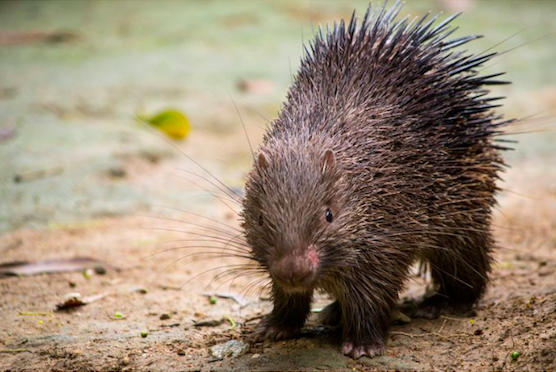
Wildlife Encounters
Colorado Rocky Mountain wildlife is a beautiful part of our mountain environment and a big reason why we love living here. However, wildlife encounters with dogs and cats can become dangerous very quickly. Here we outline some of the common wildlife our pets may encounter in our high alpine environment of Colorado and what to do if your pet encounters one these creatures. Remember, wild animals carry diseases (Rabies, Leptospirosis) that can affect dogs and cats, and even people. Never feed wild animals!
Porcupines
Porcupines are mostly nocturnal herbivores that are technically considered rodents. They move slowly and grow to be about 35 pounds. Dogs are often very curious about porcupines and will attempt to get closer to smell or even attack them.
“Porcupines have soft hair, but on their back, sides, and tail it is usually mixed with sharp quills. These quills typically lie flat until a porcupine is threatened, then leap to attention as a persuasive deterrent. Porcupines cannot shoot quills at predators as once thought, but the quills do detach easily when touched. Many animals come away from a porcupine encounter with quills protruding from their own snouts or bodies. Quills have sharp tips and overlapping scales or barbs that make them difficult to remove once they are stuck in another animal’s skin. Porcupines grow new quills to replace the ones they lose.” – National Geographic.
The biggest risk for a dog that has been quilled is migration and embedding of the quills through the chest into the lungs. This can be life threatening if not addressed right away. Quills can also penetrate joints, eyes, and become infected deep in tissue.
What to do if your pet encounters a porcupine:
- Seek immediate veterinary attention for your pet. If the event occurs after hours, seek emergency care.
- Do not attempt to remove the quills on your own. Quills are extremely painful to remove. Removal of quills in an awake animal will result in quill breakage, further embedding of the quills deeper into soft tissue, and may cause your dog to bite you out of pain.
- Do not cut the quill shafts. This makes them splinter and actually makes them more difficult to remove.
Avoidance of Porcupine Encounters:
Porcupines are most active in the summer months during dusk and dawn. That said, we do see porcupine encounters in the wintertime too! Keeping your dog on a leash is the best way to avoid them. Porcupines are not aggressive and will not attack unprovoked. Dogs that get “quilled” generally do not learn their lesson, so avoidance is the best prevention!
Moose
Moose are majestic creatures that everyone loves to see in the wild, but they can be extremely dangerous. Moose will not hesitate to charge people or animals when they are approached or if they feel threatened. Bulls are protective of their territory and females are protective of their young. A charging moose can injure you and/or your pet so keep a safe distance and do not approach them.
If your dog has been kicked or stepped on by a moose, see your veterinarian right away. Your pet could have internal bleeding or internal organ damage that you cannot detect just by looking at your pet or their behavior. If a moose charges at you and your pet, run away or get behind a large safe object like a tree or car. Keep your pet on a leash and stay a safe distance away from moose.
Mountain Goats
This wildlife encounter is one you may not have thought of, but we have seen dogs attacked by mountain goats at Breckenridge Animal Clinic. If you’ve hiked quandary, you may have seen them before. Mountain goats are not afraid of dogs. They may run to a cliffside where they can find safety from a dog, but they may just turn and charge a dog too. They can spear a dog with their horns causing a large puncture wound and causing the dog to tumble down the rocky terrain incurring additional injuries. If your dog gets into a tussle with a mountain goat, see your veterinarian right away.
Coyotes
If you cross paths with a coyote, do not run or turn your back on the animal. Slowly back away while facing the coyote, be loud and make yourself appear large. Wave your arms and throw objects as needed. The best way to avoid conflict with wildlife is to keep your dog on a leash. Do not allow your dog to play with a coyote. If you have a small dog, pick them up if you encounter a coyote. Dusk to dawn is the time coyotes are most active and an encounter is more likely. Do not leave food outside, do not feed coyotes and do not attempt to interact with them. If your dog gets into a fight with a coyote, see your veterinarian right away.
Mountain Lions
Generally, mountain lion sightings are very rare. If you make noise/ talk as you are hiking, any close by mountain lions will hear you and likely avoid you. Established guidelines do not exist for mountain lions interactions like they do for moose, coyotes and bears. Colorado Parks and Wildlife recommends hiking in groups, avoid approaching a mountain lion, stay calm if you see one, and stop and slowly back away. Running could stimulate the animal’s prey drive. Stand tall and appear large (waive your arms slowly) while slowly moving away. Speak in a firm voice. If the lion attacks you, fight back and try to remain standing. Keep your dog leashed, and pick them up if they are small. If you see or interact with a mountain lion, alert Colorado Parks and Wildlife. If your dog gets into a fight with a mountain lion, see your veterinarian right away (and call to let them know you are on your way).
Red Foxes
Red Foxes are frequently seen in town in Breckenridge and throughout Summit County. Do not feed foxes or leave food out for them. Red foxes may prey on small pets, but generally they leave larger dogs alone. Dogs may be tempted to chase them and it has been theorized that foxes are smart enough to lead dogs across busy roads where they may be hit by a car. Keep your dog leashed and do not allow them to chase foxes. If you have a small toy breed dog, pick them up if you see a fox. Contact your veterinarian right away if your pet encounters a fox.
Black Bears
Colorado is home to Black Bears, which can actually be black, shades of brown, or blonde. Bears usually hear and smell humans and dogs well before we see them and they naturally avoid us by moving in the other direction or climbing a tree. Bears are most active from mid March to early November, and at dawn and dusk. They are intelligent and resourceful animals, which is why they often find ways to get into garage containers for food. Keeping dogs leashed is the best way to prevent them from approaching a bear. You are unlikely to encounter a bear hiking, but camping and backpacking increases the risk. Bears may be attracted to food at your campsite if not properly packaged. Double bag food and utilize bear boxes or garbage hanging techniques when camping, and keep your dog close. You can hang a bear bell on your dog’s collar to help prevent them from surprising a bear. If you encounter a bear, stand still and stay calm. Do not run or climb. Keep your pet leashed. In most cases, the bear will leave first. The bear may stand on its hind limbs to get a better smell and look at you. Speak in a calm voice, wave your arms overhead slowly, and back away while facing the bear until it is out of sight. If the bear approaches you, do not feed it, stand your ground, yell, throw rocks, and if attacked, use anything you can to fight it off. Do not play dead. If your pet becomes injured by a bear, contact your veterinarian immediately.
Bats
Bats are known carriers of rabies. Bats can be encountered indoors which poses a threat to indoor cats and other pets. Injured or abnormally behaving bats are more likely to be rabid. Do not handle a bat if you find one in your home. Contact your local health department or animal control agency. If you come in contact with a bat (bite or scratch), immediately report to a health professional for evaluation as a possible rabies exposure. Contact your veterinarian if your pet was near or touched a bat.

